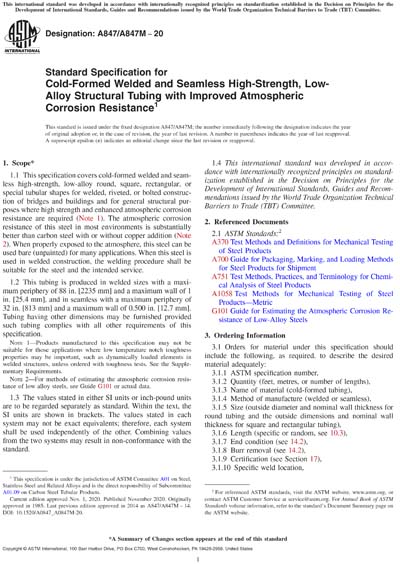Historical
ASTM A847/A847M-20
Standard Specification for Cold-Formed Welded and Seamless High-Strength, Low-Alloy Structural Tubing with Improved Atmospheric Corrosion Resistance
1.1 This specification covers cold-formed welded and seamless high-strength, low-alloy round, square, rectangular, or special tubular shapes for welded, riveted, or bolted construction of bridges and buildings and for general structural purposes where high strength and enhanced atmospheric corrosion resistance are required (Note 1). The atmospheric corrosion resistance of this steel in most environments is substantially better than carbon steel with or without copper addition (Note 2). When properly exposed to the atmosphere, this steel can be used bare (unpainted) for many applications. When this steel is used in welded construction, the welding procedure shall be suitable for the steel and the intended service.
1.2 This tubing is produced in welded sizes with a maximum periphery of 88 in. [2235 mm] and a maximum wall of 1 in. [25.4 mm], and in seamless with a maximum periphery of 32 in. [813 mm] and a maximum wall of 0.500 in. [12.7 mm]. Tubing having other dimensions may be furnished provided such tubing complies with all other requirements of this specification.
Note 1: Products manufactured to this specification may not be suitable for those applications where low temperature notch toughness properties may be important, such as dynamically loaded elements in welded structures, unless ordered with toughness tests. See the Supplementary Requirements.
Note 2: For methods of estimating the atmospheric corrosion resistance of low alloy steels, see Guide G101 or actual data.
1.3 The values stated in either SI units or inch-pound units are to be regarded separately as standard. Within the text, the SI units are shown in brackets. The values stated in each system may not be exact equivalents; therefore, each system shall be used independently of the other. Combining values from the two systems may result in non-conformance with the standard.
1.4 This international standard was developed in accordance with internationally recognized principles on standardization established in the Decision on Principles for the Development of International Standards, Guides and Recommendations issued by the World Trade Organization Technical Barriers to Trade (TBT) Committee.
Content Provider
ASTM International [astm]






